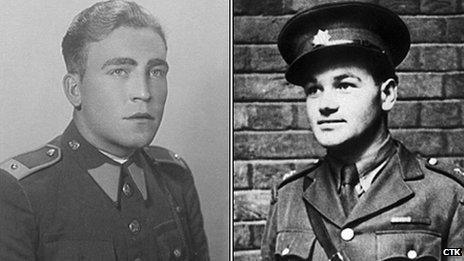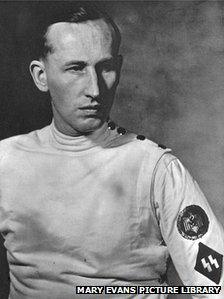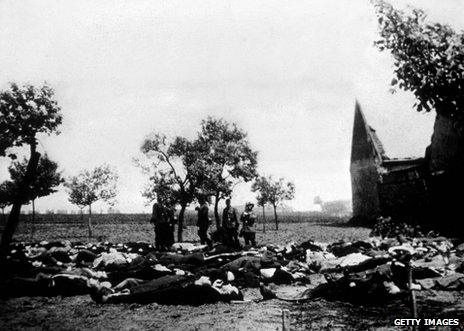Czech pride in Jan Kubis, killer of Reinhard Heydrich
- Published

Alois Denemarek (left) and Jan Kubis were childhood friends and fellow resistance activists
People in the Czech Republic are marking the seventieth anniversary of the assassination of Reinhard Heydrich, one of the most senior figures in Germany's Third Reich.
Heydrich - the overall head of security in Nazi Germany and a leading architect of the Final Solution - was killed by British-trained Czechoslovak parachutists in what was codenamed Operation Anthropoid, prompting terrible reprisals by Hitler.
Alois Denemarek was one of the last people to see Heydrich's assassin alive.
It was early June, 1942, and Mr Denemarek had travelled from his home village in Moravia to Prague. There, in a small park by the National Museum, he met his boyhood friend Jan Kubis.
Several days previously, Kubis and fellow parachutists Jozef Gabcik and Josef Valcik had carried out one of the most audacious attacks of World War Two.
In broad daylight, they had mortally wounded SS Obergruppenfuehrer Reinhard Heydrich, the acting Reichsprotektor of Bohemia and Moravia, as he was heading to Berlin for a meeting with Hitler.
Heydrich was known for his extraordinary brutality - even by Nazi standards. Hitler was beside himself with rage. The Nazis launched a massive manhunt.
"I remember what Jan said to me when I met him," Mr Denemarek, now 94, told the BBC from his home in South Moravia.
They had met to discuss how to help a wounded parachutist who the Denemarek family were sheltering in their hayloft. Kubis advised his friend not to risk bringing him to Prague.
"He said - look, things are a bit tense here at the moment."
That was something of an understatement.
Gun jammed
The story of Operation Anthropoid, devised by Britain's Special Operations Executive (SOE), has been told in countless articles, books and films.

Heydrich was a leading architect of the Final Solution
On 27 May 1942, as Heydrich's open-top Mercedes limousine slowed to round a hairpin bend in Prague, Gabcik - armed with a Sten sub-machine gun - leapt in front of the car and pulled the trigger. The gun jammed.
Heydrich ordered his driver to halt and drew his pistol. Kubis threw a bomb, which exploded near the car, and fled. Heydrich, wounded and in shock, pursued his attackers for several metres before returning to the car and collapsing.
It initially seemed the attempt to kill Heydrich had failed. But he died in Prague's Bulovka hospital eight days later, reportedly from septicaemia from the shrapnel, or possibly fragments of upholstery.
"I'm incredibly proud of what my friend did," Mr Denemarek told the BBC.
"If it wasn't for Jan, I wouldn't be here today. Half the Czech nation wouldn't be here today. Heydrich had terrible plans for us Czechs," he went on.
In January of that year, Heydrich had chaired the infamous Wannsee Conference, which set out plans for the enslavement and murder of 8 million European Jews. The Slavs, according to Heydrich's plans, would be next.
Secret betrayed
Kubis, Gabcik and Valcik hid for three weeks after the assassination before they were betrayed. On 18 June 1942, they were surrounded in the crypt of a church. For several hours, they and four comrades held off an assault by over 700 Waffen SS and Gestapo troops, who ordered the Prague Fire Brigade to flood the crypt.
Some were eventually killed in the battle, and the rest took their own lives. Bishop Gorazd, the Orthodox priest who had sheltered them, was arrested, tortured and executed.
Today, a few hundred metres from the church, on leafy Charles Square, a replica of a Nazi concentration camp has been erected, part of a series of exhibitions to commemorate the 70th anniversary. Inside the grey wooden huts are exhibits documenting the lives of 70 people who helped shelter the men.
"In 1942, the Nazi occupation of Czechoslovakia was beginning to seem like it would last forever," said journalist Mikulas Kroupa, director of the Post Bellum oral history project organising the exhibition.

The Nazis took revenge on the village of Lidice and its inhabitants
"Most Czechoslovaks were paralysed by a feeling of defeat and humiliation. The killing of Heydrich roused the people into standing up to the Nazis. It showed we were not a nation of slaves," he told the BBC.
The human cost was enormous. The men's families were rounded up and shot. The Czech villages of Lidice and Lezaky - based on flawed intelligence reports linking them to the parachutists - were razed and their inhabitants shot or sent to the camps. Another 15,000 people met the same fate.
Heydrich's 'stupidity'
Meanwhile, mass demonstrations of fealty to the Reich were held in Prague; those Czechs who attended were motivated perhaps more out of fear than grief.
Hitler organised two massive state funerals for his trusted lieutenant - one in Prague, one in Berlin. In private, however, Hitler fumed at Heydrich's "stupidity", calling his refusal to travel with a bodyguard or allow armour-plating on his car "idiotic".
The bend in the road is no longer there - it was eventually buried under a new highway by Communist city planners. Today the spot is marked by a memorial.
Alois Denemarek's family paid a heavy price for sheltering the injured parachutist. A year after Heydrich's assassination, the Gestapo burst into their farmhouse, arresting everyone inside. Mr Denemarek's brother and the parachutist were executed. His parents died in concentration camps.
Mr Denemarek himself miraculously escaped suspicion and survived. In a final ironic twist, after the war he was accused by the Communists of being a Nazi collaborator.
"Of course it was worth it, killing Heydrich," Mr Denemarek told the BBC.
"Even though it cost the lives of my family, my brother, my mother, my father and hundreds, thousands of other people."
"But as I always say - that's nothing compared to the losses we would have suffered if Heydrich had been allowed to live."
- Published17 March 2012